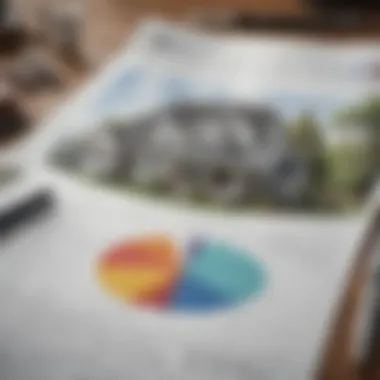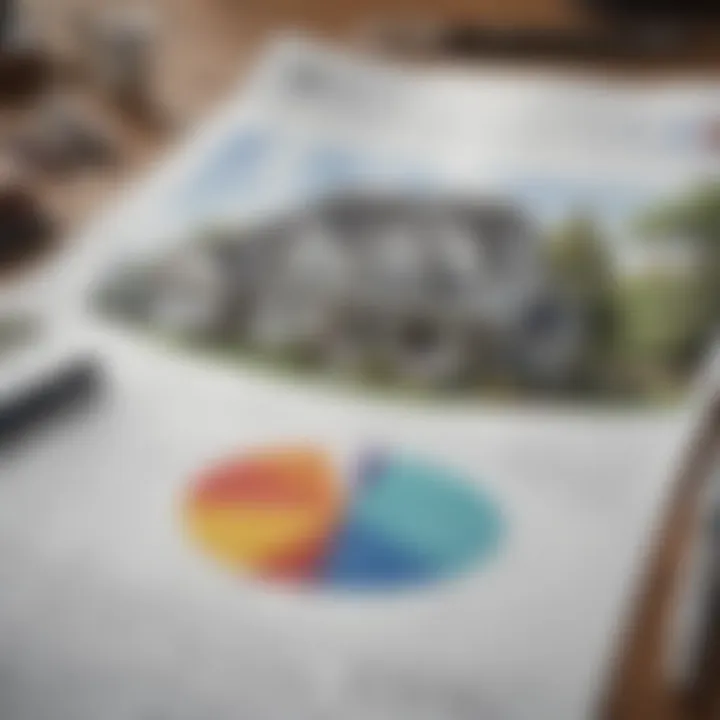Understanding the True Cost of Buying a Home


Intro
When it comes to making one of life’s biggest decisions—buying a home—the financial ramifications can feel a bit daunting. Often, buyers find themselves laser-focused on the sticker price, neglecting a vast realm of additional costs that lurk in the shadows. From down payments and closing costs to ongoing expenses like maintenance and property taxes, it’s easy to feel overwhelmed. This article sets out to illuminate the complete financial landscape associated with purchasing a home. By dissecting the various layers of expenses, we aim to provide potential homeowners with insights that go beyond basic arithmetic.
Understanding these costs enables buyers to strategize more effectively and make informed decisions. It's the difference between buying a house and making a sound investment. Let's pull back the curtain and see what's hidden behind that appealing front door.
Investment Dictionaries
Understanding Key Terms
The world of real estate is rich with jargon that can trip up even seasoned investors. Getting familiar with key terms is half the battle:
- Down Payment: This is the upfront amount a buyer pays toward the total purchase price. Often expressed as a percentage, it can range from 3% to 20% or more.
- Closing Costs: These can vary but typically range between 2% and 5% of the loan amount. This category includes a bevy of fees such as title insurance, appraisal fees, and attorney costs.
- Escrow: An arrangement where a neutral third party holds funds or documents until predefined conditions are met. It’s a safety net for buyers and sellers alike.
- Property Taxes: Ongoing expenses based on your home’s assessed value, which can vary widely depending on location.
- Homeowners Association Fees (HOA): Charged by some communities for maintenance of common areas, these costs can mount up if you’re not ready for them.
Common Investment Strategies
For those navigating their way through homebuying, it helps to consider the broader investment strategies that can apply:
- Buy and Hold: Purchasing a home to live in—and hold onto it as an investment for appreciation.
- Flipping: Buying properties at a lower price, renovating, and selling them at a profit within a short time frame.
- Rental Income: This strategy can help first-time buyers recuperate their mortgage payments by renting out part of their home or purchasing property specifically for rentals.
- Diversified Portfolio: Factor home purchases into a larger investment mix, ensuring that you aren’t putting all your eggs in one basket.
"Careful consideration of these terms and strategies not only equips potential homeowners with the tools needed to navigate the process but also positions them favorably for future investments."
Though these key terms and strategies may seem straightforward, understanding their implications in the such a significant purchase can change the playing field dramatically. Missing a single term or misunderstanding a strategy can lead one down a costly rabbit hole.
As we keep unfolding the layers of home buying, it becomes increasingly clear that each financial detail can have far-reaching effects. That's why it's so crucial to delve into the specifics, especially when it comes to financial products and market dynamics.
Intro to Home Buying Expenses
When considering the purchase of a home, it can be easy to focus solely on the sticker price. However, entering the realm of homeownership is hardly a one-dimensional decision. There are a plethora of associated costs that go well beyond what one sees in a listing or hears in a casual conversation with friends.
Defining the True Cost
The term "true cost" encompasses every financial obligation a new homeowner faces. This goes far beyond the initial down payment. For instance, potential buyers must account for closing costs. Closing costs can be a complex amalgamation of numerous fees including origination fees, inspection fees, and taxes. As these often amount to thousands of dollars, overlooking them can result in a rude awakening down the line.
Understanding what contributes to the true cost of buying a home is vital. For example, if a buyer thinks they can only muster the down payment, they may find themselves unprepared for the extensive list of additional expenditures. It's important to break down costs into categories such as initial, ongoing, and hidden costs, so that one can achieve a full picture of the required financial commitment.
Importance of Understanding Costs
Understanding these costs plays a crucial part in ensuring that any aspiring homeowner is not merely drowning in debt after the purchase is complete. When one grasp the entire financial landscape, they can budget effectively and avoid being blindsided later on.
The consequences of skipping this crucial step can be dire. Missing out on understanding utility expenses, maintenance needs, or property taxes can lead to significant financial strain. It’s not just about securing a mortgage and signing a contract; it’s also about having a sustainable plan for the future.
It’s like this: if you don't account for ongoing expenses, you might just end up feeling like a deer caught in the headlights, wondering where your money disappeared. Ultimately, the importance of being aware cannot be overstated. Gaining a fuller perspective allows individuals to make informed decisions, ensuring that the dream of homeownership becomes a reality rather than a potential financial nightmare.
"To buy or not to buy is an easy decision when you have the whole picture."


By shedding light on the true costs, this article sets the foundation for a thoughtful and well-rounded exploration into the journey of purchasing a home.
Initial Costs of Home Acquisition
When stepping into the labyrinth of home buying, one must first grapple with the initial costs of home acquisition. This phase sets the stage for the financial commitment that follows. Understanding these preliminary expenses is crucial. They often create a ripple effect on your overall budget. Not being aware of these can leave buyers feeling like they’ve stepped into a vending machine only to find they’ve missed the hidden fees. Let’s unpack this together, shall we?
Down Payment Dynamics
The down payment is typically the largest upfront cost you’ll encounter. Generally, this amount is a percentage of the home's purchase price. For example, if you're buying a home worth $300,000 and your down payment is 20%, you will need to budget $60,000 right at the get-go. A larger down payment can lead to lower mortgage payments and might even help you snag a better interest rate. However, it’s like walking a tightrope; less liquidity at hand can spell trouble for your emergencies or future investments.
Here’s a little nugget of advice: if you can manage it, putting down at least 20% can help you avoid private mortgage insurance (PMI), which can add a hefty amount to your monthly payments. It's not just about how much you need to save; it's about being strategic with your funds.
Closing Costs Breakdown
Once you’ve saved for your down payment, enter the closing costs. These fees are a collection of various expenses that can really catch homebuyers off guard. It’s not just a one-off payment either; the average is generally anywhere from 2% to 5% of the loan amount. Here’s where many buyers trip: they often ignore these costs when budgeting, thinking the down payment is their main hurdle. But the truth is, closing costs can easily run into thousands of dollars.
Title Insurance
Title insurance is one of those peculiar yet critical expenses in the mix. It protects the homeowner and lender from any disputes that might surface regarding property ownership. You pay for peace of mind, really. The big ticket here is the unique feature—this policy covers unknown issues that came up before your purchase, which can save you a bucket of cash in the long run. However, it can feel like a double-edged sword; while it's essential, it can feel like throwing money down a well if no issues arise.
Origination Fees
Origination fees emerge as another cost that can sneak up on you. This fee is essentially the lender's charge for processing your mortgage application. Typically, it runs about 0.5% to 1% of the total loan. While it’s a standard practice in the industry, the real kicker is that this cost can vary widely between lenders. So, it’s wise to shop around. You might even find lenders who waive this fee to get your business.
Appraisal Costs
Now let’s move to appraisal costs. You can think of this as having a referee in a game—appraisals ensure you’re not overpaying for that shiny new abode. Lenders typically require an appraisal to agree on the home's value. This expense usually lands between $300 and $500, depending on where you live. While this might seem trivial when stacked against the total home price, it’s a necessary step that can stop you from making a costly mistake.
Prepaid Taxes and Insurance
Lastly, don’t overlook prepaid taxes and insurance. These are usually collected at closing to set up your escrow account for the first year. You might find yourself paying several months worth of taxes upfront. The positive aspect here is that it cushions the inevitable yearly expenses. However, it's akin to a double-edged sword; while it smooths out the financial burden throughout the year, it can feel like you’re shelling out a fortune right off the bat.
In the world of home buying, preparation is the name of the game; knowing the upfront costs saves you from being blindsided once the ink is dry on that mortgage.
In the grand scheme of things, being well-acquainted with these initial costs can lead to more exact budgeting and less stress during what can be an otherwise overwhelming process.
Ongoing Financial Responsibilities
When one considers the purchase of a home, it’s easy to get caught up in the excitement of acquiring property. However, it’s essential to pull back the curtain and examine the ongoing financial responsibilities that come with being a homeowner. These expenses are crucial when forming a comprehensive picture of homeownership, often influencing decisions that can lead to financial stability or strain.
Understanding ongoing financial responsibilities is key because they can impact not just immediate budgets but also longer-term financial planning. Individuals may believe that once the keys are in hand, their financial obligations end. This couldn’t be further from the truth. Monthly commitments, variable costs, and unforeseen expenses are part of the package. Ignoring them could lead to rude awakenings down the road.
Mortgage Payments Explained
Central to the ongoing financial responsibilities of homeownership is the monthly mortgage payment. This is typically the largest expense homeowners face, combining principal and interest alongside property taxes and, often, homeowner's insurance. The way you structure your mortgage can have significant implications for your financial future.
Mortgage types can vary widely. Fixed-rate mortgages offer predictable payments over a set term, while adjustable-rate mortgages might start lower but have the potential to climb significantly. It’s crucial to shop around and understand the terms that best suit your financial picture. The goal is to strike a balance between manageable monthly payments and sufficient equity growth over time.


- Principal: This is the original loan amount. As you make payments, this amount reduces, thereby building equity.
- Interest: This is the fee charged by the lender for borrowing the money. Interest rates can fluctuate, influencing overall costs.
Property Taxes
Property taxes are an ongoing cost that can catch many new homeowners off guard. This tax, levied by local governments, is based on the property's assessed value. It's used to fund services such as schools, emergency services, and road maintenance, crucial in maintaining the community.
Homeowners should budget accordingly, as property taxes can increase. Some areas may experience sharp rises due to market conditions or new assessments. Missing these increases in your financial planning can lead to financial strain, possibly putting your home at risk if taxes go unpaid. It's wise to check your locality’s tax history for a clearer picture of potential future costs.
Homeowners Insurance Essentials
Homeowners insurance is another critical ongoing cost. It protects against damages due to incidents such as fire, theft, or natural disasters. While it might seem like merely another bill, this insurance can save you significantly down the line, should disaster strike.
The policy might also include liability protection, covering injuries that occur on your property. However, not all events are covered; for instance, typical policies may not cover floods or earthquakes without additional riders. Therefore, as you navigate your insurance options, ensure you’re fully aware of what’s included and, just as critical, what isn’t.
Homeowners Association Fees
If your home is part of a community governed by a Homeowners Association (HOA), these fees are a regular part of your financial responsibilities. HOA fees can vary widely based on amenities provided, location, and community regulations. They often cover maintenance of shared spaces, services, or even utilities in condo complexes.
While these fees can sometimes seem burdensome, consider the benefits. They can enhance property values and ensure well-maintained neighborhoods. When evaluating a potential home, taking the HOA's rules and fees into account can help you avoid unpleasant surprises post-purchase.
"A well-informed buyer is a powerful buyer; knowledge can save you from hidden pitfalls over the financial course of homeownership."
In summary, ongoing financial responsibilities are often overlooked facets of homeownership, but they can have considerable impact. Being financially prepared for mortgage payments, property taxes, insurance, and potential HOA fees allows buyers to navigate homeownership with a clearer outlook and ensures their investment is a bastion of stability rather than a source of stress.
Hidden Costs of Homeownership
When buying a home, many buyers get so focused on the obvious expenses like down payments and mortgages that they often overlook the hidden costs. Understanding these costs is crucial because they can significantly influence your financial situation long after the purchase is complete. Homeownership isn't just a matter of making monthly payments; it's also about preparing for the unexpected.
Maintenance and Repairs
Every home, regardless of age or condition, will require maintenance and occasional repairs. This cost isn’t always predictable, which adds to the challenge. On average, homeowners can expect to allocate about 1% of their home’s value annually for maintenance. This percentage can cover everything from routine tasks like lawn care to essential repairs like roof replacement or plumbing issues. Ignoring this can lead to significant expenses if things break down unexpectedly.
Key elements to consider:
- Routine Maintenance: Things like HVAC servicing, gutter cleaning, and landscaping.
- Unexpected Repairs: Water leaks or HVAC malfunctions that require immediate attention.
- Age of Your Home: Older homes often come with more frequent and extensive maintenance needs.
Utility Expenses
Once the keys are in hand and the boxes are unpacked, utility bills come knocking, and they can be a real eye-opener. Think about electricity, water, gas, and any other services. These ongoing costs can vary widely depending on where you live, the size of your home, and your personal usage patterns. It's wise to check with current homeowners in the area about their average utility expenses to get a clearer picture. Utility expenses can include:
- Electricity Bill: Costs can fluctuate seasonally, particularly in areas with extreme weather.
- Water and Sewage: Consider how much yard care or appliance usage can impact your water bill.
- Garbage Collection Fees: Often this is included in property taxes, but not always.
Emergency Fund Considerations
A common recommendation for homeowners is to have an emergency fund specifically designated for unexpected home-related expenses. This could be the difference between a minor inconvenience and a financial disaster. Ideally, this fund should cover several months' worth of mortgage payments and enough for unexpected emergencies, such as urgent repairs. Establishing this safety net can provide peace of mind and clarity in managing your finances.
Important points to factor in:
- Size of Your Fund: Aim for three to six months of necessary expenses including mortgage, utilities, and maintenance.
- Access to Funds: Ensure this money is liquid and can be accessed quickly in case of an emergency.
- Regular Review: As your home ages or your financial situation changes, revisit and adjust your fund accordingly.


"The cost of home maintenance is often underestimated, yet neglecting these expenses today can result in much larger bills tomorrow."
Being aware of these hidden costs not only prepares you for the responsibilities of homeownership but also aids in making informed financial decisions. Every dollar spent on maintenance and utilities is a dollar that must be factored into your overall budget, reinforcing the necessity of distinguishing between the purchase price and the true cost of owning a home.
Investment Perspectives on Home Ownership
When diving into the murky waters of home ownership, one must not merely skim the surface. The investment angle of buying a home brings numerous layers to consider. Simply put, understanding these perspectives can set the stage for better financial decisions down the line. Home ownership is often seen as a cornerstone of financial stability, but it is more complex than just acquiring square footage. Here, we'll explore the crucial facets such as market trends, opportunity costs, and potential tax benefits associated with buying a home.
Market Trends and Appreciation
The real estate market isn’t static; it ebbs and flows like the tide. Factors such as economic conditions, interest rates, and local development projects can significantly influence property values. A wise buyer keeps an eye not only on the current prices but also on long-term trends. For instance, a neighborhood might show promise due to new infrastructure plans or a surge in local businesses. A few key elements to watch include:
- Economic Indicators: Job growth and income levels in a specific area can lead to increased demand for homes, subsequently driving up prices.
- Supply vs. Demand: An imbalance where buyers outnumber available homes can instigate price hikes.
- Long-Term Holding: If you’re planning to stay put for several years, appreciation can work in your favor, potentially doubling your investment over time.
Understanding these dynamics aids buyers in their decision-making process, baseline prices, and future value estimations.
Opportunity Costs and Alternate Investments
Owning a home ties up a significant chunk of your capital. While for many, it’s a comfortable nest, it also raises the question: what else could you do with that money? Opportunity cost is a critical concept—especially in investments. Consider how your home purchase stacks up against other options like stocks, bonds, or even starting a business. Each comes with its own risks and rewards. A few points to ponder include:
- Diversification: Pouring all your resources into a home means missing out on the opportunity to spread your investments across multiple asset classes.
- Liquidity: Real estate is far less liquid than other investments. If life throws you a curveball, having cash in hand can be a lifesaver, whereas selling a home takes time and comes with its costs.
In deciding between home ownership and other ventures, weigh potential returns against the solidity of owning tangible property. It’s a balancing act.
Tax Deductions and Benefits
Buying a home could come with a side of tax advantages that some might overlook. Not everyone is privy to these opportunities, but being informed can lead to significant savings. Let’s highlight some key benefits a homeowner might enjoy:
- Mortgage Interest Deduction: Homeowners can often deduct interest paid on their mortgage, which can lead to hefty reductions in taxable income.
- Property Tax Deductions: These are typically deductible on federal income tax, lowering the overall tax burden.
Potentially, these deductions can result in thousands saved per year, especially in the earlier years of a mortgage when interest payments are substantially higher.
In sum, the investment perspective of home ownership is a multifaceted tapestry that weaves together market dynamics, opportunity costs, and substantial tax benefits. Understanding these elements empowers buyers to make decisions that align with their financial goals and risk tolerance.
Remember, as you navigate the path toward homeownership, keep your eyes peeled for these investment aspects. They hold significant weight in shaping your financial future.
Finale: Making Informed Decisions
Evaluating Your Financial Readiness
Before taking the plunge into home ownership, it's crucial to thoroughly assess your financial situation. This involves more than just having enough cash for a down payment. Here are some key considerations:
- Debt-to-Income Ratio: A high ratio can signal potential to lenders that you may be overleveraged. Aim for a comfortable ratio, ideally under 36%.
- Emergency Savings: Having a sturdy cushion of savings is vital. If the roof leaks or the furnace goes belly up, you need to be prepared without jeopardizing your financial stability.
- Credit Score: This little number can significantly impact the interest rates lenders offer you. A score in the high 700s can mean substantial savings over a 30-year mortgage.
"A penny saved is a penny earned." Knowing your point of readiness can prevent future headaches and ensure you’re not taking on more than you can handle.
Long-Term Financial Planning
Home ownership isn't just a present-day concern; it involves a future vision. Strategic planning ensures homeowners can weather financial storms or maximize profits when it’s time to sell. Here are essential elements to consider:
- Investment Strategy: Treat your home as an investment, not just a living space. Research neighborhoods with strong appreciation potential to bolster your return.
- Budget for Upkeep: Setting aside funds for ongoing maintenance and unforeseen repairs isn’t just wise—it's necessary. A general rule is to reserve 1% of your home's value each year for repairs.
- Refinancing Opportunities: Stay informed about interest rate changes that might allow you to refinance your mortgage at a lower rate down the line.
Taking the time to assess your financial readiness and implementing effective long-term planning can ensure you're not just buying a house, but making a lasting investment. The layers of costs involved in home ownership demand attention and understanding. Readers are better equipped to confront the challenges of home buying with careful evaluation and proactive planning, ensuring that they make informed and advantageous decisions.



